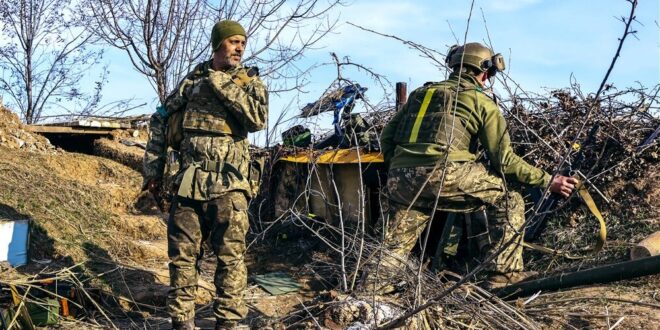The battle for Bakhmut has already become the longest and bloodiest battle of the war in Ukraine. Losses are high – on both sides, and the outcome is still uncertain. Why is Bahmut so important?
Before this war, hardly anyone had heard of Bahmut, a small town of seventy thousand inhabitants in the east of Ukraine. But the fighting for that small town in Donbas has been going on since the end of last summer, with heavy losses. Exactly how many have died – it is difficult to believe any side in the conflict, but it is certainly already about tens of thousands of victims.
The Russian side and the mercenaries of the Wagner Group claim again and again that the city has been conquered – as heard earlier this week, but this is regularly proven to be untrue. Movements on the front have been minimal for months, and often short-lived, writes Deutsche Welle .
Russian forces are trying to surround the defenders of Bakhmut with almost all their forces. However, it turned out that the statement of the commander of the Wagner Group, Yevgeny Prigozhin, from the beginning of January, that Soledar, a town near Bakhmut, had been conquered was correct. But Western intelligence services claim that the Russian forces were already a few hundred meters from the main road through which supplies to the defenders of Bahmut go, but that they were chased away, and that the road is relatively safe again.
“Easier”, but not “easy”
Since the beginning of that battle, the question has been raised again and again, is Bahmut worth so many sacrifices? There are maybe only a few thousand civilians left in Bahmut, the whole place is practically a ruin. However, it lies on the E40 road that leads from Kharkiv all the way to Russian Rostov-on-Don, and if it fell, Russian forces could more easily penetrate to the more western Ukrainian cities such as Slovyansk or Kramatorsk, important industrial and administrative centers of Donetsk.
Here, however, the emphasis should be placed on the “easier” and not the “easy” conquest of Ukrainian territories: during all those months, Russian forces penetrated barely twenty kilometers in that area.
In addition, as estimated by the British Ministry of Defense, over 20,000 soldiers died in the battle for Bahmut alone. For the sake of comparison, the USA lost 58,000 soldiers during the entire war in Vietnam, in the nine years of the USSR war in Afghanistan, probably around 26,000 Soviet soldiers died there. Former Russian President Medvedev recently stated that “if necessary, Russian soldiers will go to Kiev or even Lviv”, but it will certainly not go as the Kremlin might imagine.
Is the price for Bahmut too high?
On the other hand, not only the “generals from the couch” but also some military experts wonder whether it is wise for Ukraine not to give up the defense of Bakhmut and to lose soldiers there that it will need for a counteroffensive in other parts of the battlefield. Even if you don’t count the battlefield across the great river Dnieper, it is over 600 kilometers long. Military historian Roman Ponomarenko believes: “If we simply surrender Bahmut and withdraw our soldiers and equipment, nothing bad will happen.” But if the ring is closed, we will lose both people and equipment.”
Ralf Thiele, a former NATO military expert, also estimates that the Ukrainians’ chances of keeping Bahmut are “small”. After all, it is about the number of soldiers and the logistics of delivering ammunition to both sides, and things are not looking good for the Ukrainians.
Despite this, Ukrainian President Zelensky has already said several times that “Bahmut will hold on” and that the fighting will continue despite all the losses. Bakhmut has already become a symbol of Ukrainian defense against the Russian attack, even if it is not the only battlefield. Recently, Russian forces have been trying to penetrate into Avdijivka, a small town some forty kilometers south of Bakhmut, but there too they are suffering heavy losses. Western services report that there the 10th Russian Armored Brigade suffered heavy losses in both manpower and equipment, but the breakthrough failed.
The results are very visible
Regardless of what the strategists with their finger on the map think, the defenders of Bahmut are holding their ground and inflicting heavy casualties on any attempted attack, even though they are under constant fire from seemingly inexhaustible supplies of Russian artillery. Also, according to the assessment of the British Ministry of Defense, the battle for Bahmut has actually already been won due to the fact that the “winter offensive” of the Russian army has practically failed.
From January 11, the command of the Russian forces was personally taken over by the Chief of the General Staff of the Russian Army, General Valery Gerasimov. But over the past four months, he has definitely not been able to achieve any results that Putin would be satisfied with. Western experts would not be surprised if he were to be replaced soon, but an even bigger problem is that there are not many left of the reserve units that were engaged last summer and fall. And not only from enemy fire, but also from alcohol, accidents, even freezing.
In Moscow, there is again talk of calling for 400,000 “volunteers” to fight against the Ukrainians, and there are even announcements that a replacement for the mercenary Wagner group will be found – although there is no organization of similar size and combat readiness in Russia. In Bahmut, that group obviously didn’t achieve much either, but it raised too much dust because of the criticism of the military leadership and Russia’s strategy in this war conflict.
 Eurasia Press & News
Eurasia Press & News


